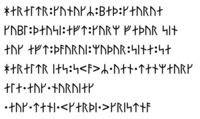Died Jelling, Denmark Children Gorm the Old | Parents Sigurd Snake-in-the-Eye Grandparents Ragnar Lodbrok, Aslaug | |
 | ||
Grandchildren Harald Bluetooth, Gunnhild, Mother of Kings, Strut-Harald Similar Gorm the Old, Harald Bluetooth, Cnut the Great, Canute IV of Denmark, Sigurd Snake‑in‑the‑Eye | ||
Harthacnut or Cnut I (Danish: Hardeknud) (born c. 880) was a legendary King of Denmark.
Contents
- Predecessors
- Rise to power
- Adam of Bremen as sole primary source
- In Ragnarssona ttr
- In Saxo
- Silverdale treasure
- References
Adam of Bremen claims that Harthacnut was the son of an otherwise unknown king Sweyn, while the saga Ragnarssona þáttr makes him son of the semi-mythic viking chieftain Sigurd Snake-in-the-Eye, himself one of the sons of the legendary Ragnar Lodbrok.
Predecessors
According to clergyman Adam of Bremen – who came from Germany to record the history of the Archbishops of Bremen – in the 890s, king Helghe was deposed and Denmark was conquered by Swedes led by Olof the Brash.
Along with two of his sons, Gyrd and Gnupa, Harthacnut took the realm "by force of arms," and they ruled it together, thus founding the House of Olaf in Denmark. Adam reports that they were followed by a Sigtrygg. That Sigtrygg was the son of Gnupa, by a Danish noblewoman named Asfrid, is shown on two runestones near Schleswig, erected by his mother after his death.
Rise to power
Adam tells that after Sigtrygg reigned a short time, during the tenure of Archbishop Hoger of Bremen (909–915/917), Harthacnut (Danish: Hardeknud), son of king Sweyn, came from "Northmannia," the "land of the Northmen," by which he may have meant Norway, Normandy, which had recently been colonized by Danish Vikings, or even northern Jutland. Harthacnut immediately deposed the young king Sigtrygg, and then ruled unopposed for approximately thirty years. However, the Saxon chronicles of Widukind of Corvey report the defeat and forced baptism of the Danish king Chnuba in 936 at the hands of German king Henry. Likewise, Olav Tryggvasson's Saga tells of Gnupa's defeat by Gorm the Old. Some historians (e.g. Storm) have taken these as indications that Sigtrygg's father Gnupa still ruled at least part of Denmark much later than credited by Adam of Bremen.
Adam of Bremen as sole primary source
The only primary source about Harthacnut of Denmark are two clauses from Adam of Bremen (1,52 and 1,55).
1,52 reads: king Sveins son, Hardegon in the oldest manuscript which was later changed to king Sveins son, Harthacnut but also changed to king Sveins son, Athelstan.
1,55 says Hardecnudth Vurm, a double name not uncommon in that era, later changed to Hardecnudths son, Vurm but also changed to Athelstan Vurm. Historians generally agree that Vurm (English: worm or serpent) is a German rendering of the Danish name Gorm, which allows for an interpretation that Harthacnut and Gorm were originally the same person. 1,56 says Vurm had been attacked by King Heinrich I (916–936). That attack was in 934 and Widukind 1.40 says the Danish king's name was Chnuba.
Even though Adam names king Sweyn Estridsson as his source, this does not preclude the possibility of errors on his part. Adam's history contains other statements that are rejected or deemed unlikely by historians.
In Ragnarssona þáttr
The saga Ragnarssona þáttr relates the acts of the sons of Ragnar Lodbrok, and proceeds to link them genealogically to the later rulers of the Scandinavian kingdoms. It makes Harthacnut son of Sigurd Snake-in-the-Eye. Scholarly opinion is divided as to the degree to which the material found in such heroic sources is to be taken as authentic history and genealogy.
In Saxo
In the late and legend-influenced Gesta Danorum of Saxo Grammaticus, Hardakanute appears as Knut. He is described as a son of Erik, a descendent of Ragnar Lodbrok, by Gudorm, the granddaughter of Harald Klak. In his version of the tale, Hardakanute is raised by Ennignup (suggested to be Saxo's rendition of Gnupa), but never accepts Christianity.
Silverdale treasure
In the Silverdale Hoard is a silver coin impressed with the name "Airdeconut" an Anglicized variant of "Hardeknut". The silver treasure is roughly dated to the time that Hardeknut lived.
